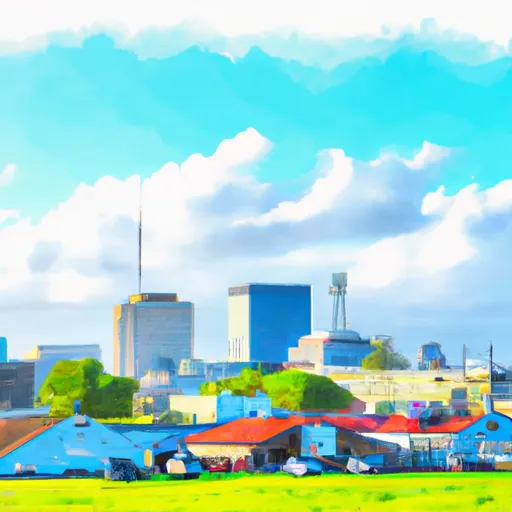-
 Snoflo Premium
Snoflo Premium
Get unlimited access to all our content
With no Ad interruptions! - Start Your Free Trial Login with existing account
Houma
Eden Index
Climate
6.5
•
Recreation
2.8
•
Community
2.8
•
Safeguard
4.3/10

Houma, Louisiana is a small city located in Terrebonne Parish and serves as the parish seat. Situated in the southern part of the state, Houma experiences a humid subtropical climate characterized by hot, humid summers and mild winters. Summers are typically long and hot with temperatures averaging around 90°F (32°C), while winters are short and mild with temperatures averaging around 60°F (15°C). The area receives a significant amount of rainfall throughout the year, with the wettest months being May through September.
Hydrologically, Houma is surrounded by the Gulf of Mexico, the Intracoastal Waterway, and various bayous and marshes. These waterways provide ample opportunities for outdoor recreation, such as fishing, boating, and kayaking. The region is known for its abundant wildlife, including alligators, birds, and fish species, making it a popular destination for nature enthusiasts and birdwatchers.
In addition to water-based activities, Houma offers outdoor recreational opportunities on land. The city has several parks and trails where individuals can enjoy activities like hiking, biking, and picnicking. Notably, the nearby Mandalay National Wildlife Refuge provides a unique opportunity to explore and observe the diverse ecosystem of the Louisiana wetlands.
What is the Eden Index?
The Snoflo Eden Index serves as a comprehensive rating system for regions, evaluating their desirability through a holistic assessment of climate health, outdoor recreation opportunities, and natural disaster risk, acknowledging the profound impact of these factors on livability and well-being.
Climate Health Indicator (CHI): 6.5
Houma receives approximately
1622mm of rain per year,
with humidity levels near 90%
and air temperatures averaging around
21°C.
Houma has a plant hardyness factor of
9, meaning
plants and agriculture in this region tend to thrive here all year round.
By considering the ideal temperature range, reliable water supplies, clean air, and stable seasonal rain or snowpacks, the Climate Health Indicator (CHI) underscores the significance of a healthy climate as the foundation for quality living.
A healthy climate is paramount for ensuring a high quality of life and livability in a region, fostering both physical well-being and environmental harmony. This can be characterized by ideal temperatures, reliable access to water supplies, clean air, and consistent seasonal rain or snowpacks.
Weather Forecast
Streamflow Conditions
Central Louisiana Coastal
Area Rivers
Central Louisiana Coastal
Snowpack Depths
Central Louisiana Coastal
Reservoir Storage Capacity
Central Louisiana Coastal
Groundwater Levels
Recreational Opportunity Index (ROI): 2.8
The Recreational Opportunity Index (ROI) recognizes the value of outdoor recreational options, such as parks, hiking trails, camping sites, and fishing spots, while acknowledging that climate plays a pivotal role in ensuring the comfort and consistency of these experiences.
Access to outdoor recreational opportunities, encompassing activities such as parks, hiking, camping, and fishing, is crucial for overall well-being, and the climate plays a pivotal role in enabling and enhancing these experiences, ensuring that individuals can engage in nature-based activities comfortably and consistently.
Camping Areas
| Campground | Campsites | Reservations | Toilets | Showers | Elevation |
|---|---|---|---|---|---|
| Tickfaw State Park | None | 15 ft | |||
| Deer Leap | 46 | 338 ft | |||
| North Rec Composite | 15 | 97 ft | |||
| Little Sunflower River | None | 107 ft | |||
| Rocky Springs - Natchez Trace Pkwy | 22 | 235 ft | |||
| Lamar Dixon Expo RV Center | 300 | 11 ft | |||
| South Recreation Composite | 100 | 140 ft | |||
| Lake Charlie Capps | None | 146 ft | |||
| Leroy Percy State Park | None | 108 ft | |||
| Float Camp | 16 | 472 ft |
Nearby Ski Areas
Catastrophe Safeguard Index (CSI):
The Catastrophe Safeguard Index (CSI) recognizes that natural disaster risk, encompassing floods, fires, hurricanes, and tornadoes, can drastically affect safety and the overall appeal of an area.
The level of natural disaster risk in a region significantly affects safety and the overall livability, with climate change amplifying these risks by potentially increasing the frequency and intensity of events like floods, fires, hurricanes, and tornadoes, thereby posing substantial challenges to community resilience and well-being.
Community Resilience Indicator (CRI): 2.8
The Community Resilience Indicator (CRI) recognizes that education, healthcare, and socioeconomics are crucial to the well-being of a region. The CRI acknowledges the profound impact of these elements on residents' overall quality of life. By evaluating educational resources, healthcare accessibility, and economic inclusivity, the index captures the essential aspects that contribute to a thriving community, fostering resident satisfaction, equity, and social cohesion.

